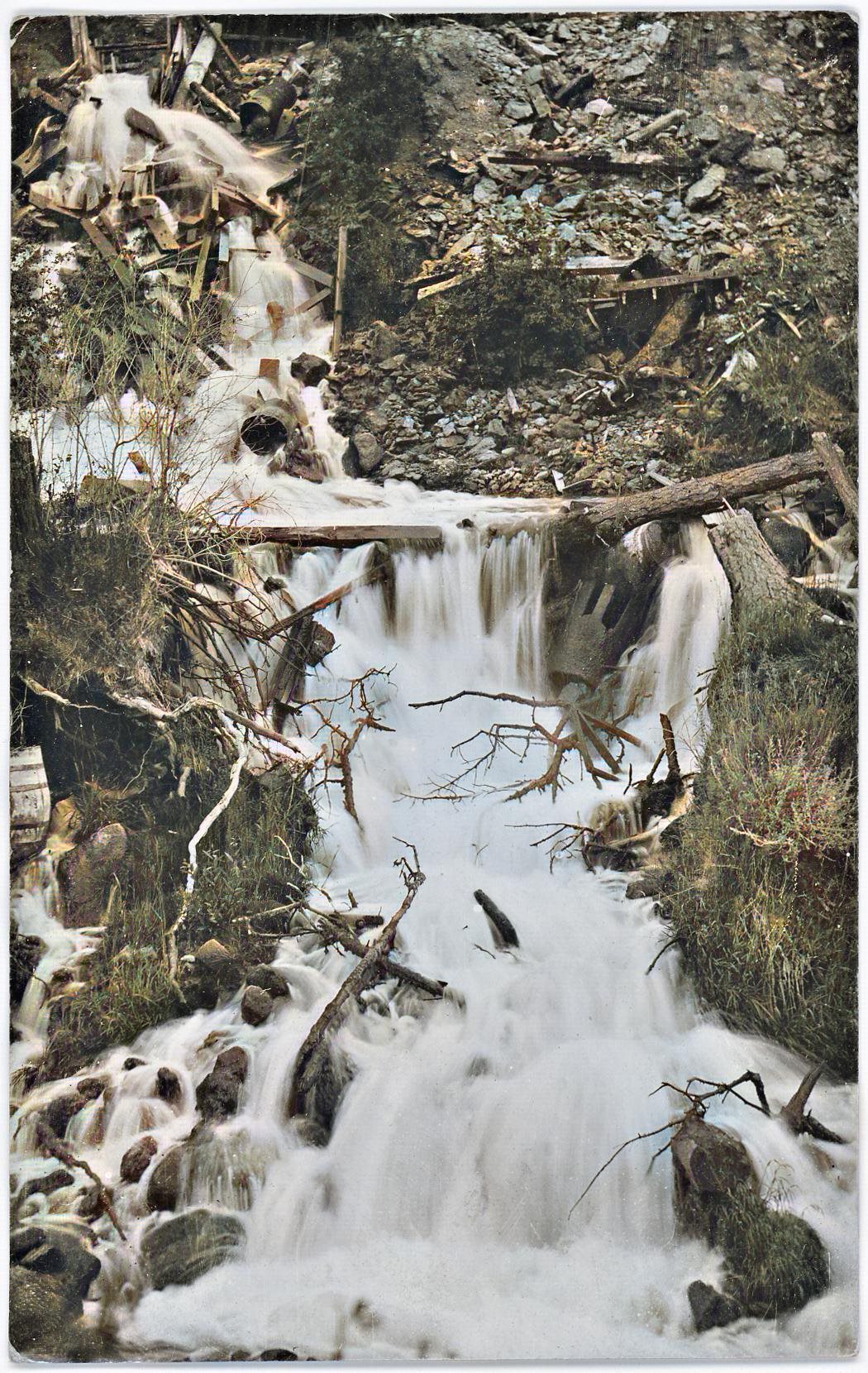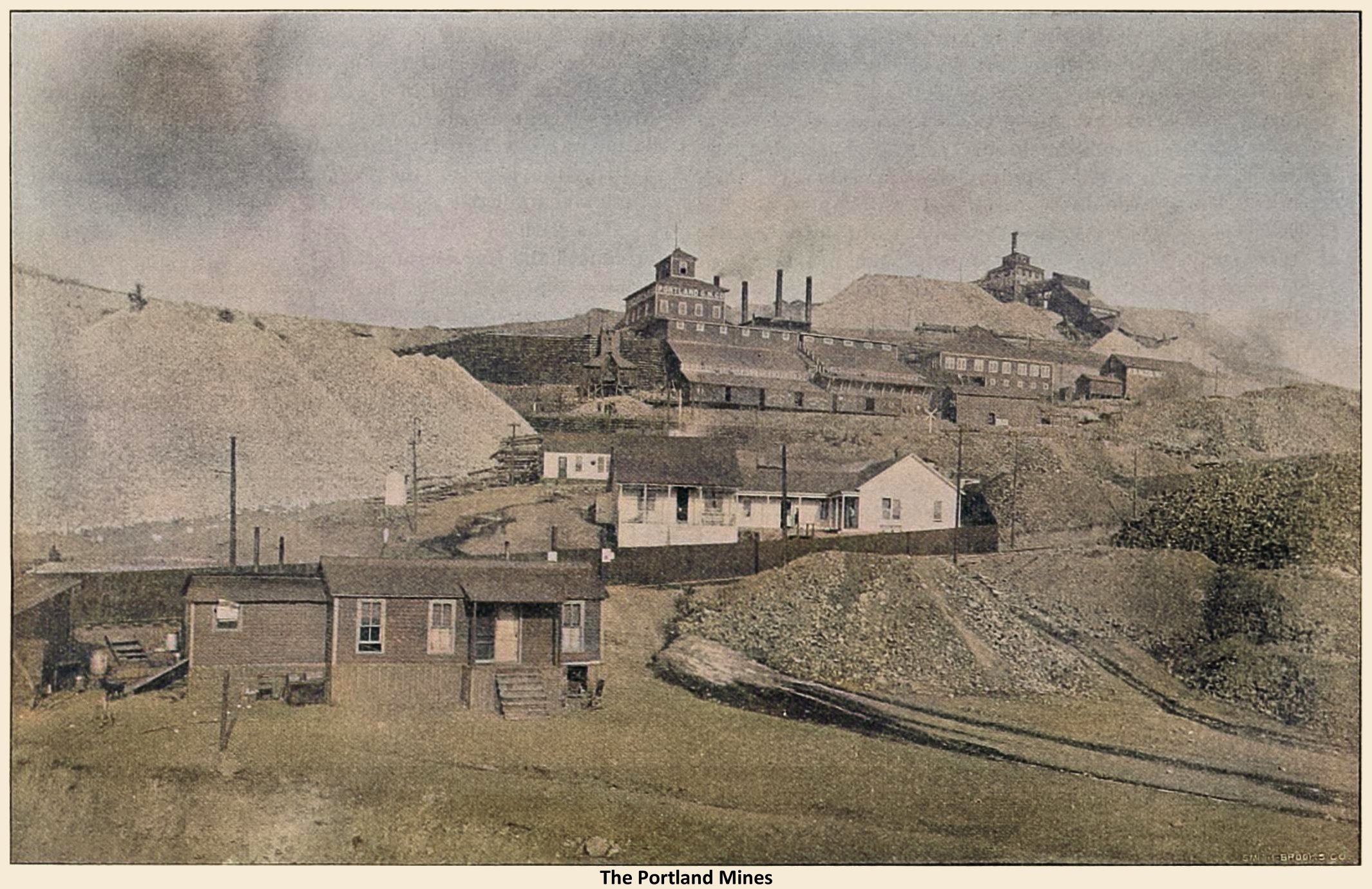-> HathiTrust Digital Library Site; Link First Page.
I substituted a reused image from my collection for the source image of the Portland Mines as mine is slightly better, in addition I added the reused waterfall image.
Cleaned up and fixed a couple of typos.
The Roosevelt tunnel has not been fully completed, although driven to the point at which a heavy flow of water was expected. This point is commonly known as the "Black Belle" water course, and when cut by the El Paso tunnel (175 ft. directly above) it yielded a flow of 5,000 to 6,000 gal. per minute.
In the Roosevelt tunnel, this same water course, or probably the same, furnishes a flow of but 1,750 gal. per minute. This flow is coming in at various points along a length of about 200 ft. of tunnel. Meantime, a steady discharge of about 5,000 gal. is entering the tunnel from the El Paso churn drill hole, some 1,000 ft. back from the heading. The total flow from the Roosevelt tunnel is, therefore, from 6,500 to 7,000 gal. per minute.
Actual measurements of the flow since water was first encountered have been as follows:
| Date— | Flow from Tunnel Heading, Gal. per Min. |
El Paso Drill Hole, Gal. per Min. |
Total. |
| October 1, 1910 | 80 | . . . | 80 |
| October 16, 1910 | 90 | . . . | 90 |
| November 1, 1910 | 175 | . . . | 175 |
| November 13, 1910 | 100 | 650 | 750 |
| November 17, 1910 | 100 | 950 | 1050 |
| November 19, 1910 | 200 | 1440 | 1640 |
| November 22, 1910 | . . . | . . . | 2630 |
| December 8, 1910 | . . . | . . . | 6210 |
| December 17, 1910 | . . . | . . . | 6240 |
| December 22, 1910 | 950 | 4306 | 5256 |
| January 2, 1911 | 1340 | 4135 | 5475 |
| January 11, 1911 | 1730 | 4920 | 6650 |
| January 18, 1911 | 1730 | 5145 | 6875 |
A flow of about 7000 gal. is the maximum capacity of the tunnel waterway and a larger quantity would seriously interfere with the work of driving the tunnel. A much larger quantity of water could be admitted to the tunnel through the churn drill hole if it were not for this fact.
On December 24 the tunnel company discontinued work in the main heading and began driving a crosscut to the north about 700 ft. back from the breast. This crosscut is intended to connect with the C. K. & N. vein and water course within a distance of 600 ft.
It is confidently expected that a large flow of water will be developed, for the reason that in all the levels of the El Paso mine from the 300 ft. to the 1,000 ft. level, whenever this vein has been cut, it has furnished a strong flow of water. It will require about 60 days to finish this crosscut, when it is hoped we will have nearly if not quite double the present flow.
Meantime, the general water level all over the district is being steadily lowered. The subsidence at the Elkton main shaft, which is probably a fair average of the entire west side of the district, has been as follows:
- November 20, 0.7 ft.
- November 27, 3.1 ft.
- December 5, 5.7 ft.
- December 12, 8.7 ft.
- December 19, 10.8 ft.
- December 26, 12.4 ft.
- January 2, 14.5 ft.
- January 16, 18.3 ft.
The fall in the Battle mountain shafts has been somewhat less than this, and at the other west side shafts, somewhat more. It is probable that the average subsidence of the general water level for the entire district is not less than 17 ft. up to the present time.
I estimate the total flow from the Roosevelt tunnel up to January 20, as, approximately, 510 million gallons. Assuming the average fall to be 17 ft. this would indicate a storage of underground waters in the district equal to 30 million gallons per vertical foot. But the flow from the tunnel has been too irregular and the time too short to come to any general conclusion in that respect.
The total cost of the Roosevelt tunnel to date has been in round numbers $540,000.
The total length of tunnel driven (not including the intermediate shaft, stations and crosscuts) is 15,746 ft. This makes an average cost of about $34 per lineal foot for tunnel actually driven.
The cost of pumping the water which has so far flowed from the Roosevelt tunnel would be not less than $50,000, and that under the most favorable conditions. If, as expected, it lowers the general water level a total of 730 ft., the saving in pumping expense will be several times the cost of the tunnel.
* Engineer, Cripple Creek Drainage Tunnel Association.

